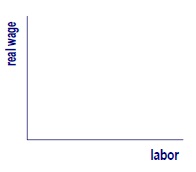Problem1)The Consumption-In this question, you will use the basic (one period) consumption-leisure framework to consider some labor market issues.
Suppose the representative consumer has the following utility function over consumption and labor
u(c,l)= ln c-A/(1+Φ) n1+Φ
where, as usual, c denotes consumption and n denotes the number of hours of labor the consumer chooses to work. The constants A and Φ are outside the control of the individual, but each is strictly positive. (As usual, ln(.) is the natural log function.)
Suppose the budget constraint (expressed in real, rather than in nominal, terms) the individual faces is c- (1-t).w.n, where t is the labor tax rate, w is the real hourly wage rate, and n is the number of hours the individual works.
Recall that in one week there are 168 hours, hence n + l = 168 must always be true.
The Lagrangian for this problem is
ln c -A/(1+Φ) n1+Φ +λ[(1-t)wn-c]
in which λ denotes the Lagrange multiplier on the budget constraint.
a. Based on the given Lagrangian, compute the representative consumer’s first-order conditions with respect to consumption and with respect to labor. Clearly present the important steps and logic of your analysis.
b. Based on ONLY the first-order condition with respect to labor computed in part a, qualitatively sketch two things in the diagram below. First, the general shape of the relationship between w and n (perfectly vertical, perfectly horizontal, upward-sloping, downward-sloping, or impossible to tell). Second, how changes in t affect the relationship (shift it outwards, shift it in inwards, or impossible to determine). Briefly describe the economics of how you obtained your conclusions. (IMPORTANT NOTE: In this question, you are not to use the first-order condition with respect to consumption nor any other conditions.)

c. Now based on both of the two first-order conditions computed in part a, construct the consumption-leisure optimality condition. Clearly present the important steps and logic of your analysis.
d. Based on both the consumption-leisure optimality condition obtained in part c and on the budget constraint, qualitatively sketch two things in the diagram below. First, the general shape of the relationship between w and n (perfectly vertical, perfectly horizontal, upward-sloping, downward-sloping, or impossible to tell). Second, how changes in t affect the relationship (shift it outwards, shift it in inwards, or impossible to determine). Briefly describe the economics of how you obtained your conclusions.

e. How do the conclusions in part d compare with those in part b? Are they broadly similar? Are they very different? Is it impossible to compare them? In no more than 60 words, describe as much as you can about the economics (do not simply restate the mathematics you computed above) when comparing the pair of diagrams.